You can beat VR nausea by starting with 10-15 minute sessions and gradually increasing playtime. Optimize your headset’s fit by adjusting interpupillary distance and securing straps properly. Use natural head movements instead of joystick controls, and choose teleportation over smooth locomotion. Keep your play area cool with fans and good airflow. Try ginger supplements 1-2 hours before gaming, stay hydrated, and take immediate breaks when symptoms appear. These strategies will transform your virtual experience.
Start With Short VR Sessions and Gradually Build Tolerance
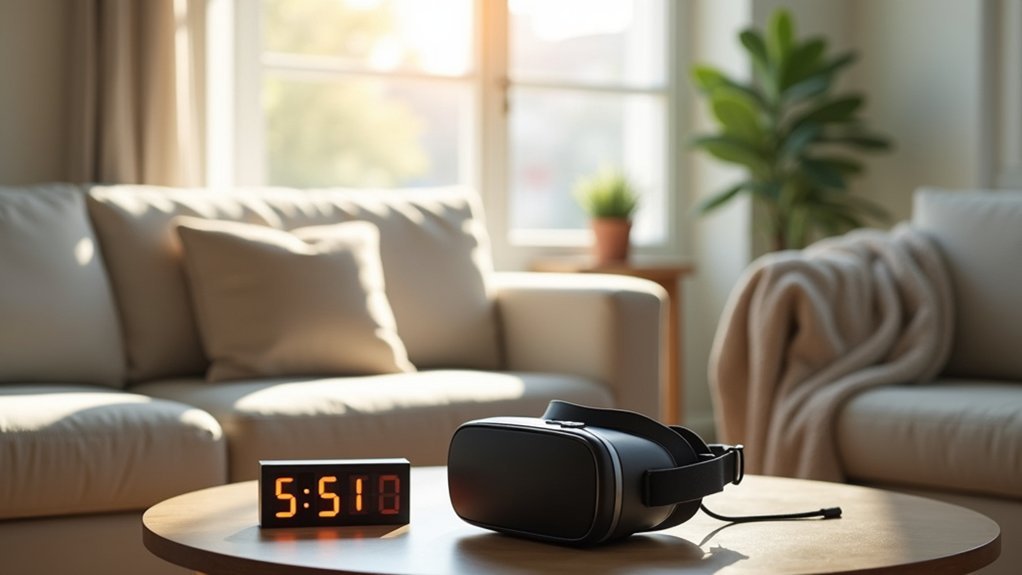
When you’re new to virtual reality, you’ll want to start with short VR sessions to prevent your senses from becoming overwhelmed.
Begin with 10-15 minute sessions, then gradually increase your playtime by a few minutes each day as you build tolerance. Focus on stationary games initially before moving to dynamic environments that might trigger motion sickness.
Start slowly with brief VR sessions and stationary games, then gradually progress to more dynamic experiences as your tolerance builds.
Take breaks immediately if you feel dizzy or nauseous – don’t push through discomfort. Step away and let your body recalibrate before continuing. This approach helps avoid overwhelming your system while allowing your brain to adapt to VR’s unique sensory input.
Consistency and patience are key to successfully building your VR tolerance. With regular, controlled exposure over several days, you’ll greatly reduce your risk of experiencing motion sickness.
Optimize Your Headset Setup for Maximum Comfort
A properly fitted headset forms the foundation of comfortable VR experiences and dramatically reduces your chances of developing motion sickness.
Start by adjusting your interpupillary distance to match your personal measurements—incorrect IPD settings cause blurry images and eye strain that trigger nausea.
Next, secure the straps so your headset sits snugly on your head’s crown, distributing weight evenly across your skull.
Use the glasses spacer even without prescription eyewear, as it enhances comfort settings and reduces facial pressure.
Regularly adjust the lenses for ideal clarity since misalignment worsens motion sickness symptoms.
Consider investing in third-party straps that improve balance and reduce nausea through better weight distribution.
These simple adjustments transform VR headsets from uncomfortable devices into gateways for extended, enjoyable virtual adventures.
Use Natural Head Movements Instead of Controller Navigation
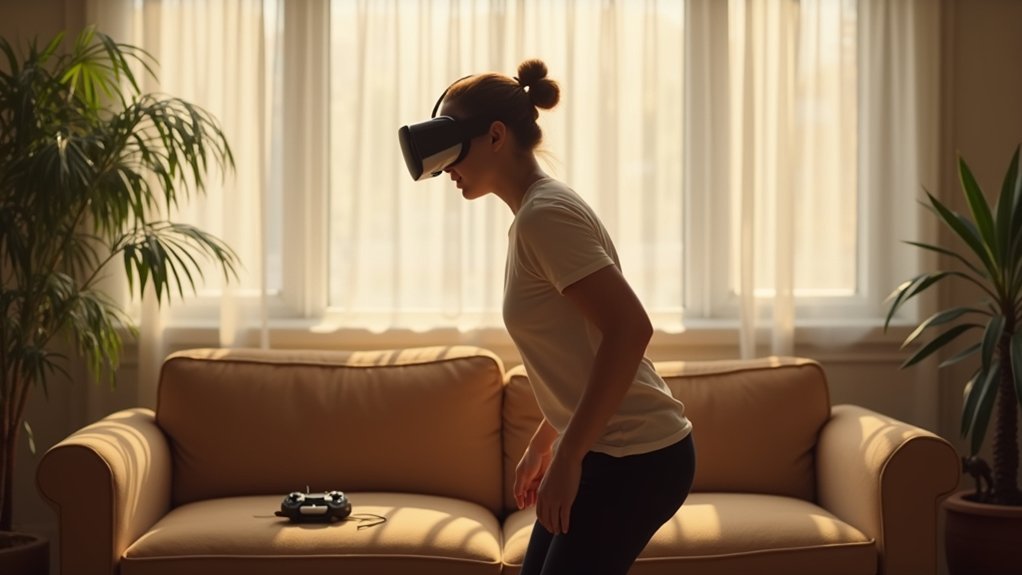
When you’re exploring VR environments, rely on turning your actual head rather than using joystick controls to look around.
This natural movement alignment helps prevent the cognitive dissonance that triggers motion sickness by keeping your visual input synchronized with physical movement.
Set yourself up in a swivel chair or clear guardian space where you can easily rotate and move your head without physical strain or obstruction.
Head Vs Joystick Control
Since your brain expects visual and physical inputs to match, using natural head movements instead of joystick controls creates a more harmonious VR experience that considerably reduces nausea.
When you rely on joystick control for navigation, you’re creating a disconnect between what your eyes see and what your body feels, which triggers motion sickness symptoms.
Natural head movement aligns your physical actions with the virtual environment, making the immersive experience feel more intuitive and comfortable.
This approach considerably minimizes nausea in VR by eliminating the sensory conflict that causes discomfort.
- Use a swivel chair or stand within your guardian space for 360° viewing
- Turn your head instead of using controller sticks to look around
- Combine head movements with room-scale walking when possible
Natural Movement Alignment Benefits
Why does your brain struggle with VR navigation when you use controller sticks instead of natural movements?
Controller navigation creates disconnect between visual input and physical sensation, triggering VR motion sickness. When you move through virtual environments using joysticks, your eyes see movement while your body remains stationary, causing cognitive dissonance.
Natural movement through head movements eliminates this conflict. Your brain expects visual changes when you turn your head, making the immersive experience feel authentic. This alignment between physical action and visual feedback prevents disorientation that controller navigation creates.
Using a swivel chair enhances this effect, allowing smooth natural movement while maintaining stability. Your vestibular system receives expected signals from head movements, dramatically reducing nausea risk and creating seamless VR navigation.
Swivel Chair Setup Tips
A proper swivel chair transforms your VR setup into a nausea-prevention powerhouse. When you physically turn to look around instead of using joystick controls, you’ll eliminate conflicting sensory signals that trigger motion sickness.
This setup encourages natural head movements that align with your VR environment, creating a more immersive experience while maintaining balance and stability.
Your swivel chair enables smooth 360° views without the dizziness that comes from rapid virtual turning. By matching physical movement with visual input, you’ll greatly reduce the disconnect that causes nausea.
- Choose a chair with smooth, quiet rotation to avoid distracting squeaks during gameplay
- Ensure adequate clearance around your chair for full 360° rotation without hitting obstacles
- Position yourself at ideal distance from your play space boundaries for comfortable turning
Choose Movement Options That Minimize Disorientation
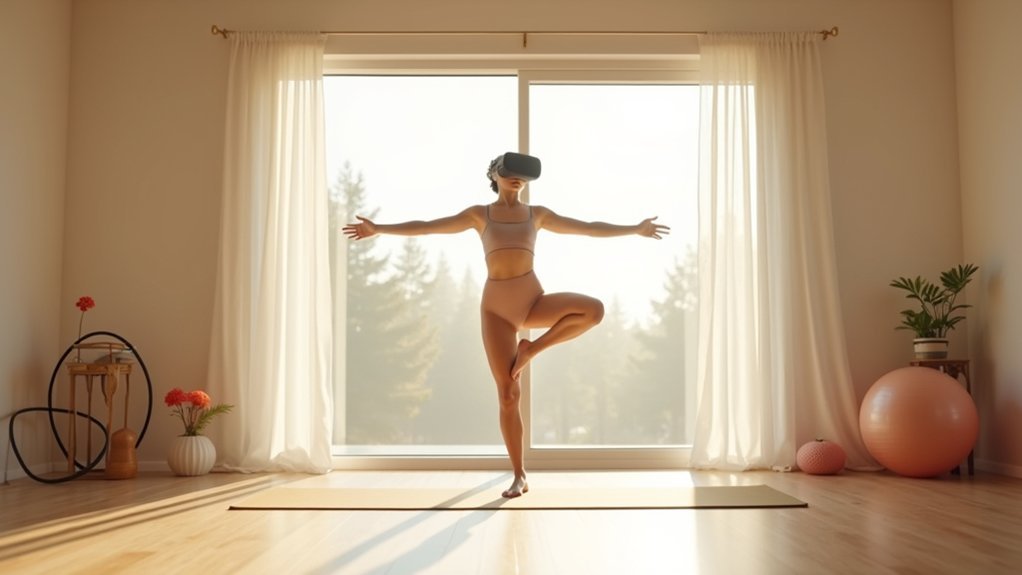
When you’re selecting VR experiences, your choice of movement mechanics can make the difference between an enjoyable session and a nauseating ordeal.
Opt for teleportation mechanics that let you instantly jump between locations without the jarring disconnect of traditional locomotion. Stationary experiences like Beat Saber or on-rails shooters eliminate excessive movement that triggers nausea.
Teleportation and stationary VR experiences prevent motion sickness by eliminating the jarring movement that causes nausea during gameplay.
Use head movements for navigation instead of joystick controls, which creates natural alignment between your visual input and physical motion.
Adjust in-game settings to slow movement speeds and enable comfort features like reduced field of view. Look for games with fixed points of focus and clear visual cues that help stabilize your perception.
These movement options considerably reduce motion sickness while maintaining immersion.
Create an Environment That Supports Your Body’s Balance
Your physical environment plays a vital role in preventing VR nausea by supporting your body’s natural balance systems.
You’ll want to optimize your play space by clearing obstacles and ensuring you have adequate room to move safely without bumping into furniture or walls.
Additionally, proper cooling and airflow help regulate your body temperature and reduce discomfort that can contribute to motion sickness during extended VR sessions.
Optimize Physical Space Setup
Since your body relies on environmental cues to maintain balance, creating the right physical space can dramatically reduce VR nausea before it starts.
Your setup directly impacts how comfortable you’ll feel during VR experiences.
Start by ensuring your headset has a comfortable fit that doesn’t create strain or pressure points.
Clear your play area of obstacles to allow natural physical movement without fear of collision.
Proper lighting helps minimize glare that can worsen disorientation when shifting between virtual and real worlds.
Key elements for ideal VR space:
- Air circulation – Use fans to maintain cool temperatures and reduce nausea
- Spatial awareness tools – Place textured mats underfoot to ground yourself physically
- Environmental control – Adjust room brightness to complement your virtual environment
These adjustments create a foundation that supports your body’s natural balance mechanisms.
Use Cooling and Airflow
Beyond enhancing your physical setup, temperature control and airflow play a powerful role in preventing VR nausea. A fan blowing cool air on you keeps your body temperature down and greatly improves comfort during gameplay. This increased airflow mimics outdoor conditions, helping reduce nausea and disorientation that’s common in VR experiences.
| Cooling Method | Benefit |
|---|---|
| Desktop fan | Prevents overheating and sweating |
| Ceiling fan | Creates consistent air circulation |
| Open window | Provides natural ventilation |
| Portable fan | Targeted cooling for face/neck |
| Air conditioning | Maintains ideal room temperature |
Proper ventilation counteracts the sweating that occurs inside headsets, while circulating air helps enhance experience quality. Users consistently report that simple adjustments like using fans dramatically improve their VR tolerance and enjoyment.
Try Natural Remedies and Supplements Before VR Sessions
While pharmaceutical solutions exist for motion sickness, natural remedies can offer a gentler approach to preventing VR nausea. Taking a ginger supplement one to two hours before VR sessions can effectively reduce nausea for many users. This medically proven remedy works whether you choose capsules, chews, or even ginger ale.
Ginger supplements taken 1-2 hours before VR sessions provide a medically proven, natural alternative to pharmaceutical motion sickness treatments.
Key preparation strategies include:
- Stay hydrated – Drink plenty of water before and during virtual reality use, as dehydration worsens motion sickness symptoms.
- Avoid eating beforehand – Skip meals right before VR to prevent a full stomach from triggering nausea.
- Experiment with ginger forms – Try different options like supplements, candy, or drinks to find what works best for you.
These natural approaches can greatly improve your VR experience without relying on medication.
Take Strategic Breaks When Symptoms Begin to Appear
When you notice the first signs of VR nausea or dizziness, immediately pause your session rather than pushing through the discomfort. Stop playing and allow your body to recover before symptoms worsen.
| Break Activity | Benefit |
|---|---|
| Walk around | Promotes circulation |
| Drink water | Prevents dehydration |
| Get fresh air | Clears your head |
| Take a ginger supplement | Reduces nausea naturally |
| Rest eyes | Relieves visual strain |
Hydration during breaks is essential since dehydration can worsen motion sickness. Light physical activity like walking helps restore your equilibrium and makes you feel better faster.
Don’t wait until you experience VR motion sickness severely. Instead, incorporate regular breaks every 15-20 minutes throughout your gaming session. This proactive approach maintains a positive VR experience and prevents discomfort from escalating.
Frequently Asked Questions
How to Reduce Motion Sickness in VR Chat?
Start with short VR Chat sessions and gradually increase playtime. Use teleportation instead of walking, adjust your headset’s IPD setting, enable comfort settings, and make certain you’re in a well-ventilated room.
Why Do I Get so Nauseous Playing VR?
You’re experiencing VR nausea because your brain receives conflicting signals – your eyes see movement in the virtual world while your body remains stationary, creating sensory confusion that triggers nausea symptoms.
How Long Does a VR Hangover Last?
Your VR hangover typically lasts a few minutes to several hours, though it can extend over a day if you’re prone to motion sickness. You’ll recover faster with hydration, fresh air, and rest.
How to Prevent VR Headaches?
You’ll prevent VR headaches by adjusting your headset properly, setting correct interpupillary distance, taking regular breaks, using comfort settings in games, and staying hydrated before and during sessions.

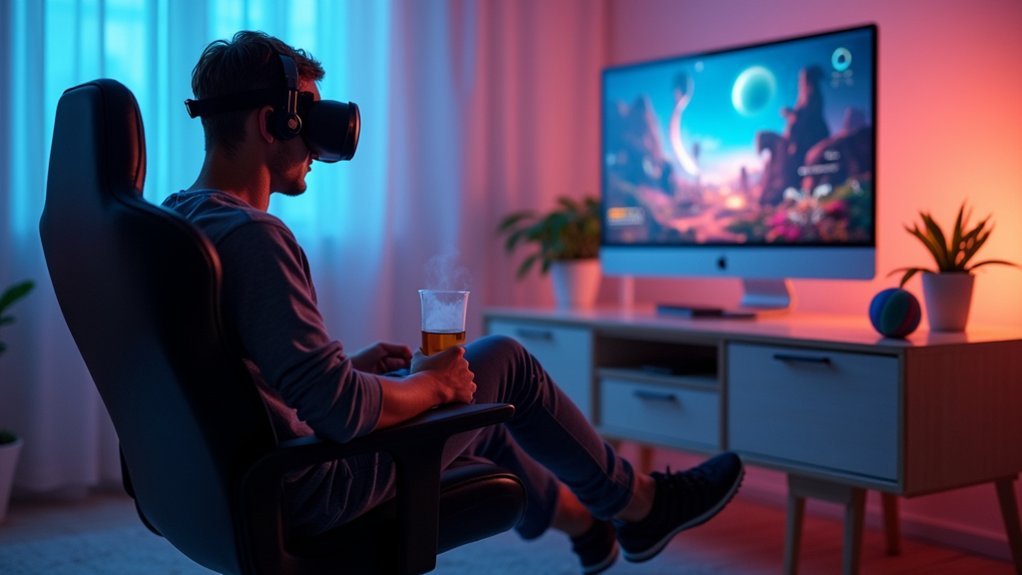
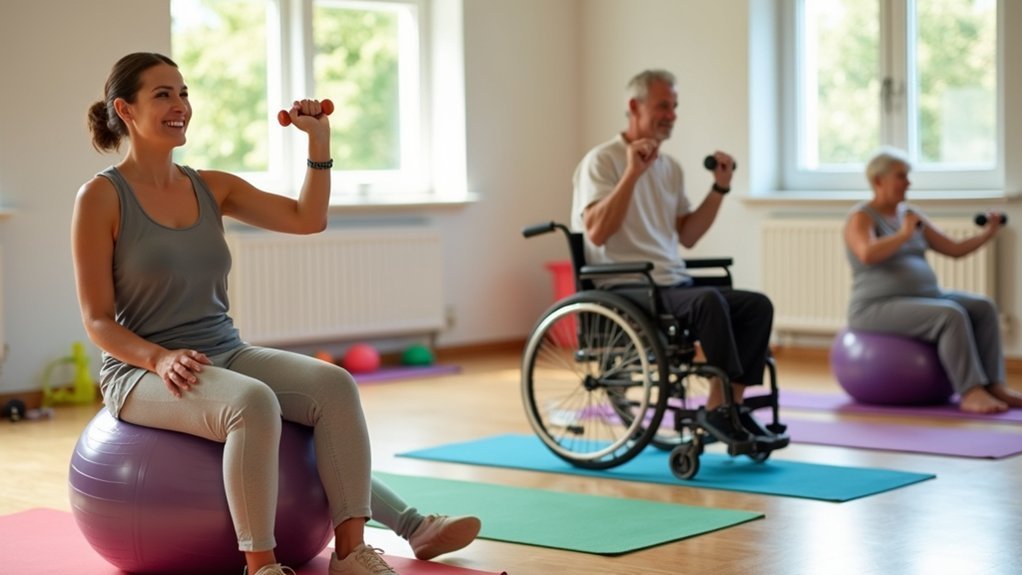
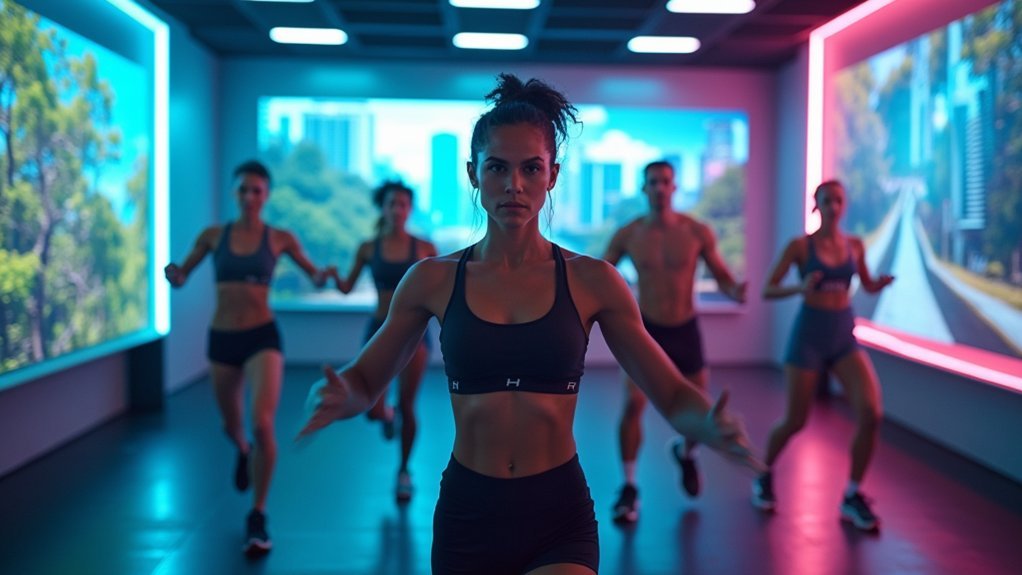

Leave a Reply